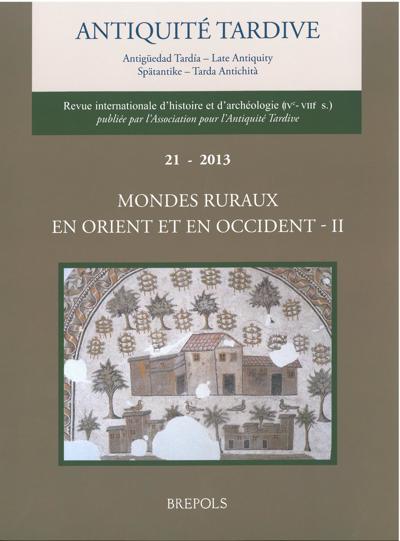Antiquité Tardive 21 (2013)

Dossier – Mondes ruraux en Orient et en Occident – II
Resp. G. Cantino Wataghin et H. Inglebert
6 – Le vocabulaire
J.-M. Carrié, Nommer les structures rurales entre fin de l’Antiquité et Haut Moyen Âge : le répertoire lexical gréco-latinet ses avatars modernes (2de partie) [Naming rural structures from Late Antiquity to the Early Middle Ages: the graeco-latin lexical resources and their modern uses (part 2)]
7 – Les campagnes en périphérie de l’Empire romain
A.S. Esmonde Cleary, Northern Britain in Late Antiquity [Le nord des îles Britanniques dans l’Antiquité tardive] ;
A. Stuppner, Die ländliche Besiedlung im mittleren Donauraum von der Spätantike bis zum Frühmittelalter [Rural settlements in the middle Danube region from Late Antiquity to Middle Ages] ;
A. Poulter, Goths on the lower Danube: their impact upon and behind the frontier [Les Goths du Bas Danube : leur impact sur et au-delà de la frontière]
8 – Les formes de l’habitat
Cl. Negrelli, Le strutture del popolamento rurale tra IV e IX secolo in Emilia Romagna e nelle Venezie [Structures of the rural settlement of the Venetian area and Emilia Romagna between the 4th and 9th centuries] ;
E. Ariño, El hábitat rural en la Península Ibérica entre finales del siglo IV y principios del VIII: un ensayo interpretativo [L’habitat rural dans la péninsule Ibérique entre la fin du ive et le début du VIIIe siècle : un essai interprétatif] ;
M. Veikou, Settlements in the Greek countryside from 4th to 9th century: forms and patterns [L’habitat rural en Grèce du IVe au IXe siècles : formes et modes d’occupation] ;
C. Duvette, avec G. Charpentier, C. Piaton, Maisons paysannes d’un village d’Apamène, Serğilla (IVe-VIe siècles – Massif calcaire de la Syrie du Nord) [Rural dwellings of northern Syria (4th-6th centuries – ğebel Zāwiye, village of Serğilla)] .
I. Taxel, Identifying social hierarchy through house planning in the villages of Late Antique Palestine: the case of Ḥorvat
Zikhrin [L’identification de la hiérarchie sociale à travers l’agencement des villages dans la Palestine de l’Antiquité tardive : le cas de Ḥorvat Zikrhin] ;
D. Mattingly, M. Sterry, V. Leitch, Fortified farms and defended villages of Late Roman and Late Antique Africa [Fermes et villages fortifiés de l’Afrique romaine dans l’Antiquité tardive]
9 – Le rôle des implantations ecclésiales
G. Cantino Wataghin, Le fondazioni ecclesiastiche nelle vicende delle aree rurali: spunti di riflessione per l’Occidente tardo antico (IV-V secolo) [Ecclesiastical foundations in rural areas: some remarks about the Late Antique West (4th-5th centuries)] ;
Y. Codou, L’église et l’habitat dans le Midi de la France aux Ve-Xe siècles [Church and settlement in southern France in the 5th to 10th centuries] ;
M. A. Cau, C. Mas, Christians, peasants and shepherds: the transformation of the countryside in Late Antique Mallorca
(Balearic islands) [Chrétiens, paysans et bergers : la transformation des campagnes à Majorque (îles Baléares) pendant l’Antiquité
tardive]
10 – Les rapports entre villes et campagnes
D. Fernandez, City and countryside in Late Antique Iberia [Ville et campagne de la péninsule Ibérique dans l’Antiquité tardive] ;
F. Cantini, Aree rurali e centri urbani tra IV e VII secolo: il territorio toscano [Rural areas and urban centres from 4th to 7th centuries: the case of Tuscany]
_____________
Varia
V. Goncalves, Aleae aut tesserae ? Les significations d’une opposition ludique dans la Rome d’Ammien Marcellin [Aleae aut tesserae? The meanings of gaming opponents in the Rome of Ammianus Marcellinus] ;
A. J. Kosto, The transformation of hostageship in Late Antiquity [La transformation de l’institution de l’otage dans l’Antiquité tardive] ;
Chr. Freu, Les salariés de la terre dans l’Antiquité tardive [Hired labourers on Late Antique estates] ;
St. Del Lungo, Provincia Lucania: topografia e agrimensura in un paesaggio che cambia, dalla Tarda Antichità all’Alto
Medioevo (prima parte) [Provincia Lucania: topography and land survey in a changing landscape, from Late Antiquity to the Early
Middle Ages (part 1)] ;
P. Grossmann, Überlegungen zum ursprünglichen Grundriss der Kirche von Orléansville (Chlef, Algeria) und ein Beitrag zur Entstehung der christichen Basilika [A new assessment of the original plan of the church of Orléansville (Chlef, Algeria), and thoughts on the beginnings
of the Christian basilica type] ;
S. Ordóñez Agulla, J. Sánchez Velasco, E. García Vargas, S. García-Dils de la Vega, M. A. Tabales Rodríguez, Novedades arqueologicas de las sedes episcopales de la Bética Occidental [New archaeological research on the episcopal sees of western Betica] ;
A. Uscatescu, Visual arts and paideia: the triumph of the theatre, revisiting the Late Antique mosaic of Noheda [Arts visuels et paideía : le triomphe du théâtre à travers la mosaïque de Noheda revisitée]
Chronique
S. Ratti, Païens et chrétiens au ive siècle : points de résistance à une doxa [Pagans and Christians in the 4th century: points of disagreement with a doxa] ;
B. Laszlo Toth, Regards nouveaux sur le trésor de Nagyszentmiklós, à la suite d’une publication majeure [New insights on the hoard of Nagyszentmiklós, following a major publication on the subject]
Comptes rendus




